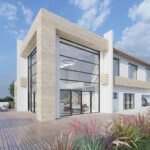As environmental concerns continue to grow globally, the architectural community in Paphos is increasingly embracing sustainable practices. These methods not only reduce the ecological footprint but also enhance the quality of life for residents. Here’s a look at some of the sustainable architecture practices being adopted in Paphos.
1. Energy-Efficient Design
Energy efficiency is a cornerstone of sustainable architecture. In Paphos, architects are designing buildings that minimize energy consumption through:
- Insulation: Proper insulation in walls, roofs, and floors to reduce the need for heating and cooling.
- Natural Ventilation: Utilizing natural airflow to cool buildings, reducing reliance on air conditioning.
- Solar Orientation: Positioning buildings to maximize natural light and heat from the sun, lowering energy use.
2. Use of Renewable Energy
Harnessing renewable energy sources is becoming increasingly common in Paphos. Many buildings now feature:
- Solar Panels: Photovoltaic panels are installed on rooftops to generate electricity from the abundant sunshine in Cyprus.
- Solar Water Heaters: Utilizing solar energy to heat water, significantly reducing electricity or gas consumption.
- Wind Energy: Some projects are exploring the use of small-scale wind turbines to supplement energy needs.
3. Sustainable Materials
The choice of materials plays a critical role in sustainable architecture. Architects in Paphos are prioritizing:
- Local Materials: Using locally sourced materials like limestone and wood to reduce transportation emissions and support the local economy.
- Recycled and Reclaimed Materials: Incorporating materials such as recycled steel, reclaimed wood, and repurposed bricks to minimize waste.
- Low-Impact Materials: Opting for materials with low environmental impact, such as bamboo, cork, and natural stone.
4. Water Conservation
Water is a precious resource, and sustainable architecture in Paphos includes several water-saving measures:
- Rainwater Harvesting: Collecting and storing rainwater for use in irrigation, flushing toilets, and other non-potable applications.
- Greywater Systems: Recycling greywater from sinks, showers, and washing machines for landscape irrigation.
- Low-Flow Fixtures: Installing low-flow faucets, showerheads, and toilets to reduce water usage.
5. Green Roofs and Walls
Green roofs and walls are being integrated into modern buildings in Paphos to provide multiple environmental benefits:
- Thermal Insulation: Green roofs help insulate buildings, reducing heating and cooling costs.
- Stormwater Management: They absorb rainwater, reducing runoff and lowering the risk of flooding.
- Urban Biodiversity: Green walls and roofs create habitats for birds and insects, promoting urban biodiversity.
6. Passive Solar Design
Passive solar design takes advantage of the sun’s energy to heat and cool buildings naturally. Key strategies include:
- Thermal Mass: Using materials that absorb and store heat during the day and release it at night.
- Window Placement and Shading: Strategically placing windows and using shading devices to control solar gain.
- Daylighting: Maximizing natural light to reduce the need for artificial lighting.
7. Smart Home Technologies
Integrating smart home technologies can enhance sustainability by optimizing energy and resource use. Common features include:
- Smart Thermostats: Automatically adjust heating and cooling settings based on occupancy and weather conditions.
- Energy Monitoring Systems: Track energy consumption in real-time, helping residents identify and reduce wasteful practices.
- Automated Lighting: Use sensors and timers to control lighting, ensuring lights are only on when needed.
Conclusion
Sustainable architecture is vital for creating resilient and eco-friendly communities. In Paphos, architects are increasingly adopting these practices to build structures that are not only environmentally responsible but also economically and socially beneficial. By embracing sustainability, Paphos is paving the way for a greener, more sustainable future.







